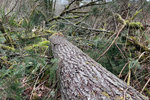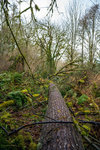

If you want to feel like a shrimp in a kelp forest, a good place to start is in a real forest on a windy day, your back on a log, trees flexing like grasses above you, the sky crowded with clouds raking the treetops like the undersides of waves.
My eyes dart from one towering treetop to the next as I watch, wondering which might be the next to hit its breaking point. A thousand flutters turn to contortions.
The log on which I lie is the latest casualty, a large fir that has been down a few weeks at most, everything about it fresh and fragrant. I am in a forest that has been kept whole by a conservation easement. A neighboring parcel was clearcut this winter. I am here to see what life is like on the edge of clearcut and forest, where trees that were once sheltered by their neighbors must now bear the full force of wind and sun.
I’ve been in my fair share of dangerous situations in the Key Peninsula’s natural world, and this ranks right up there. What gets me is the sound, as it often does when I know that one slip of the balance means I’ll be crushed by forces far larger than me — the soft tick of dislodged stones when I’m high on an unstable bluff, the whisper of an incoming tide when it reaches the spot I have sunk into tideflat quicksand.
Right now it is rock and roll. Tumult. The man who brought me here is looking pretty rock and roll himself. As we hiked to this place he was going off on how it should be illegal to log right to a property line, how loggers should be held responsible when neighbors’ trees are thrown by the wind. (There are no property line buffers, and few recourses for neighbors who lose timber.)
When his curses ran out, our talk turned to various logging jobs visible on the KP, the cuts we have witnessed, how it’s obvious when it’s done well and when it is not. Some clearcuts are springing back with a diverse mix of young trees, evidence that some care was taken during and following the cut, while others are choked with Scotch broom and brambles. One of the latter is just north of where we are. Eight years old, it also borders the conserved forest. I have peered into it, and crossing it looks impossible. Not a single young fir can be seen.
No matter what you think about the practice of clearcutting, when you see that kind of lost landscape, it’s hard not to come away with the sour feeling that something has been pillaged, that someone got while the getting was good and left without a thought for the future. Along with a forest’s ability to regenerate, logging itself will die if the responsibility to replant and manage continues to be shirked.
“This was my favorite part of the walk,” says my companion. Finding the large fir across the trail has turned his anger bitter and reflective. “It was so dark in here, just moss everywhere.”
It is a low area, damp, full of salmonberry and sword ferns below tall maples, cedars and hemlocks scattered throughout. The fir was one of four in a loose grove and the largest by far. I walk the length of its trunk, three feet thick at the base, and after passing through terrains of crushed salmonberry and smashed young maples mixed with fresh fir greenery, I arrive at a tree height north of 175 feet.
The root wad stands 15 feet tall. Two teenaged cedars came with it. The hole behind is only a few feet deep. The fir stood on hardpan.
In the general vicinity I count an alder, two hemlocks, and two maples that have also fallen this winter. They too are uprooted — trees that were used to wind protection. One of the maples fell in huge chunks and narrowly missed the gravestone of an unknown homesteader. It smashed a kiosk next to the trail. A hemlock snag with its first woodpecker holes has toppled. A patch of moss on a log has been bleached like coral. Wind is one thing. The sun will be another.
Back at my companion’s house, his wife nods when he tells her about the fir. “Oh, I told you,” she says. It was evening during the last windstorm, she was in the kitchen, and the whole house shook when it fell. “I knew we lost a big one.”
Later I return alone to lie on the fir again. The wind has intensified. I plan escape routes. Next to me is a small pile of maple helicopters, each split in half, the seed removed. This squirrel must not be into sprouted food because two of the helicopters have green shoots curling hopelessly over the downed tree’s bark.
In lulls I hear a frog call. Then certain gusts rattle like antlers or bones overhead. I am getting chilled, or the chills. Out across the clearcut I notice a different quality of noise where the gusts smack broadside into a wall of tall firs, another property line. It is a single discordant note, a noise in every register that is quite different from the shifting soundscape above, where gusts move in three dimensions through trees of different species. In that wall, the firs strain in unison. They are like a sandstone shoreline being hit by breakers.
When I finally quit the fir, I see one maple leaning on another leaning on another, their crowns shoved together like brooms in a closet. It’s impressive. But one tree holding up two others is not a situation that can last. Trees are like us. To find a shape, a tree needs to stand in its own space, even as it benefits from the support of those around it. Today’s wind tears through the gaps. Not all of the trees here will fall. But there will be more.
UNDERWRITTEN BY THE FUND FOR NONPROFIT NEWS (NEWSMATCH) AT THE MIAMI FOUNDATION, THE ANGEL GUILD, ADVERTISERS, DONORS AND PEOPLE WHO SUPPORT INDEPENDENT, NONPROFIT LOCAL NEWS